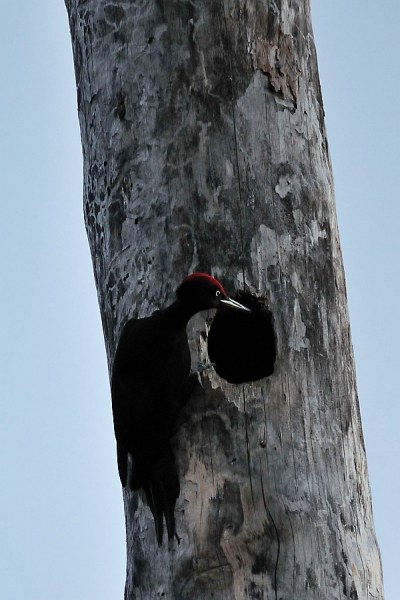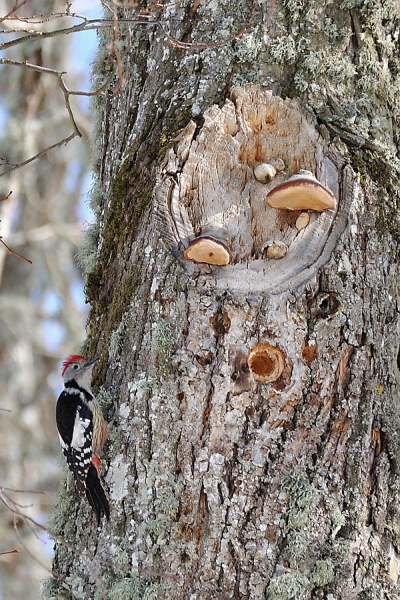New Cameras
Woodpeckers building nests
Text and photos Rein Kuresoo, animalcity.eu/kuresoo/
Translation: Liis
As soon as the daytime temperatures rose above zero, the sufferings of woodpeckers were a little eased: they no longer have to bang their heads against trees ringing from cold – in the noon hours the tree trunk can already turn quite warm. Now they can carry on with their life. You might think that the woodpeckers, the major real estate developers in the forest, could relax a little and let loose sometimes in spring, beat their drums and grind their behinds. But no, only one look at last year’s nest is sufficient to make clear that a new home must be hacked out. The old nest is no longer really hygienic or safe. Where suitable trees are few in the forest the woodpecker pair may build their nest in a tree where they already have nested, but usually a new site is chosen. The black woodpecker has a very urgent reason for this.
A black woodpecker inspecting its old nest hollow. The flight opening of black woodpecker nests is an oval. The lower part of the opening is made at a slight angle so that rain water will drain outwards.
If the world were a fair place all Tengman’s owls, stock doves, goldeneyes, squirrels and pine martens should line up and make a deep bow to the black woodpecker whose old homes they use. But knowing these brethrens I can say that ingratitude is all that they will offer the master builder. The proximity of the born predator, the Tengmalm’s owl, can be a little dangerous for the black woodpecker. But the black woodpecker, and all other birds and mammals who take over the black woodpecker’s nest hollows, must seriously fear the pine marten. Those who take the trouble to sort out a pine marten’s track paths in winter soon discover that on the ground they often run up close to black woodpeckers’ nest hollows and squirrels’ nests. Evidently the marten has all the hollows, burrows and squirrels’ nests in its territory mapped, and at least in winter they are checked over and over again at certain intervals. During the breeding period the numerous mice and the bird chicks may divert the marten’s attention and provide some nesting peace for the inhabitant of the woodpecker hollow. Tengmalm’s owls that crouch in the nest hollows even in winter seem to suffer worst from the present great number of pine martens. When the black woodpecker constructs a new nest hollow in spring, it takes some time before the marten gets this on its nest chart, and usually the rearing of chicks succeeds in that period. Quite often the black woodpecker makes its nest in the seed pines left on large clearings – evidently because martens stray around less frequently on the clearing lots.
The black woodpecker and the great spotted woodpecker are the only ones among our woodpeckers that manage to hack out their nest in a completely healthy tree, the other woodpeckers always search for decayed spots, and their nest-building proceeds much faster. For the black woodpecker it takes five weeks to hollow out a nest, the middle spotted woodpecker can manage in two weeks.
The middle spotted woodpecker started building its nest during the first days of April. The woodpecker with the small beak would not have the strength to hollow out sound oak wood, the nest is always made in decaying parts of the trunk.









